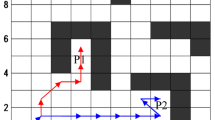Abstract
To solve the problems of convergence speed in the ant colony algorithm, an improved ant colony optimization algorithm is proposed for path planning of mobile robots in the environment that is expressed using the grid method. The pheromone diffusion and geometric local optimization are combined in the process of searching for the globally optimal path. The current path pheromone diffuses in the direction of the potential field force during the ant searching process, so ants tend to search for a higher fitness subspace, and the search space of the test pattern becomes smaller. The path that is first optimized using the ant colony algorithm is optimized using the geometric algorithm. The pheromones of the first optimal path and the second optimal path are simultaneously updated. The simulation results show that the improved ant colony optimization algorithm is notably effective.


















Similar content being viewed by others
References
Borenstein J, Koren Y (1991) Histogramic in motion mapping for mobile robot obstacle avoidance. IEEE J Robotics Autom 7(4):535–539
Botzheim J, Toda Y, Kubota N (2012) Bacterial memetic algorithm for offline path planning of mobile robots. Memet Comput 4(1):73–86
Brooks RA (1986) A robust layered control system for a mobile robot. IEEE J Robotics Autom 2(1):14–23
Castillo O, Trujillo L, Melin P (2007) Multiple objective genetic algorithms for path-planning optimization in autonomous mobile robots. Soft Comput 11(3):269–279
Cheng CT, Fallahi K, Leung H, Tse CK (2010) An auvs path planner using genetic algorithms with a deterministic crossover operator. In: International conference on robotics and automation (ICRA), pp 2995–3000
Erin B, Abiyev R, Ibrahim D (2010) Teaching robot navigation in the presence of obstacles using a computer simulation program. Proc Soc Behav Sci 2(2):565–571
Geng P, Wang Z, Zhang Z, Xiao Z (2012) Image fusion by pulse couple neural network with shearlet. Opt Eng 51(6):067,005–067,005–7
Gu B, Sheng VS, Tay KY, Romano W, Li S (2015) Incremental support vector learning for ordinal regression. IEEE Trans Neural Netw Learn Syst 26(7):1403–1416
Kang B, Wang X, Liu F (2014) Path planning of searching robot based on improved and ant colony algorithm. J Jilin Univ Eng Technol Ed 44(04):1062–1068
Khatib O (1986) Real-time obstacle avoidance for manipulators and mobile robots. Int J Robotics Res 5(1):90–98
Lim KK, Ong YS, Lim MH, Chen X, Agarwal A (2008) Hybrid ant colony algorithms for path planning in sparse graphs. Soft Comput 12(10):981–994
Liu Z, Zhang Y, Jing Z, Wu J (2010) Using combination of ant algorithm an immune algorithm to solve tsp. Control Decis 25(5):695–700
Luo D, Wu S (2010) Ant colony optimization with potential field heuristic for robot path planning. Syst Eng Electron 32(6):1277–1280
Ma T, Zhou J, Tang M, Tian Y, Al-Dhelaan A, Al-Rodhaan M, Lee S (2015) Social network and tag sources based augmenting collaborative recommender system. IEICE Trans Inf Syst 98(4):902–910
Mavrovouniotis M, Yang S (2011) A memetic ant colony optimization algorithm for the dynamic travelling salesman problem. Soft Comput 15(7):1405–1425
Parpinelli RS, Lopes HS (2015) A computational ecosystem for optimization: review and perspectives for future research. Memet Comput 7(1):29–41
Peng G, Wang Z, Liu S, Zhuang S (2015) Image fusion by combining multiwavelet with nonsubsampled direction filter bank. Soft Comput 1–13. doi:10.1007/s00500-015-1893-0
Savsani P, Jhala RL, Savsani V (2014) Effect of hybridizing biogeography-based optimization (bbo) technique with artificial immune algorithm (aia) and ant colony optimization (aco). Appl Soft Comput 21(5):542–553
Shi E, Chen M, Li J, Huang Y (2014) Research on method of global path-planning for mobile robot based on ant-colony algorithm. Trans Chin Soc Agric Mach 45(6):53–57
Shuang B, Chen J, Li Z (2011) Study on hybrid ps-aco algorithm. Appl Intel 34(1):64–73
Sttzle T, Hoos H (1997) Improvement on the ant system: introducing max-min ant system. Proceed. International conference on artificial neural networks and genetic algoritms. Springer-Verlag, Vienna, pp 246–250
Wang P, Feng Z, Huang X (2008) An improved ant algorithm for mobile robot path planning. Robot 30(6):554–560
Wang Y (2015) Hybrid maxmin ant system with four vertices and three lines inequality for traveling salesman problem. Soft Comput 19(10):585–596
Wei J, Cheng F, Zhao D, Tao Y, Ding S, Lü J (2013) Obstacle avoidance method of apple harvesting robot manipulator. Trans Chin Soc Agric Mach 44(11):254–259
Wen X, Shao L, Xue Y, Fang W (2015) A rapid learning algorithm for vehicle classification. Inf Sci 295(1):395–406
Wu X, Guo B, Wang J (2009) Mobile robot path planning algorithm based on particle swarm optimization of cubic splines. Robot 31(6):556–560
Xie S, Wang Y (2014) Construction of tree network with limited delivery latency in homogeneous wireless sensor networks. Wirel Pers Commun 78(1):231–246
Xu X, Zhu Q (2012) Multi-artificial fish-swarm algorithm and a rule library based dynamic collision avoidance algorithm for robot path planning in a dynamic environment. Acta Electron Sin 40(8):1694–1700
Zhao Y, Zhang H, Kong G (2015) Image segmentation by generalized hierarchical fuzzy c-means algorithm. J Intel Fuzzy Syst 28(2):961–973
Acknowledgments
This study was funded by Chinese High-tech R&D (863) Program (Grant Number 2007AA04Z232), the Natural Science Foundation of China (Grant Numbers 61075027, 91120011), and the Natural Science Foundation of Hebei province (Grant Numbers F2010001106, F2013210094).
Author information
Authors and Affiliations
Corresponding author
Ethics declarations
Conflict of interest
The authors declare that there is no conflict of interests regarding the publication of this paper.
Ethical approval
This article does not contain any studies with human participants performed by any of the authors.
Additional information
Communicated by V. Loia.
Rights and permissions
About this article
Cite this article
Liu, J., Yang, J., Liu, H. et al. An improved ant colony algorithm for robot path planning. Soft Comput 21, 5829–5839 (2017). https://doi.org/10.1007/s00500-016-2161-7
Published:
Issue Date:
DOI: https://doi.org/10.1007/s00500-016-2161-7




